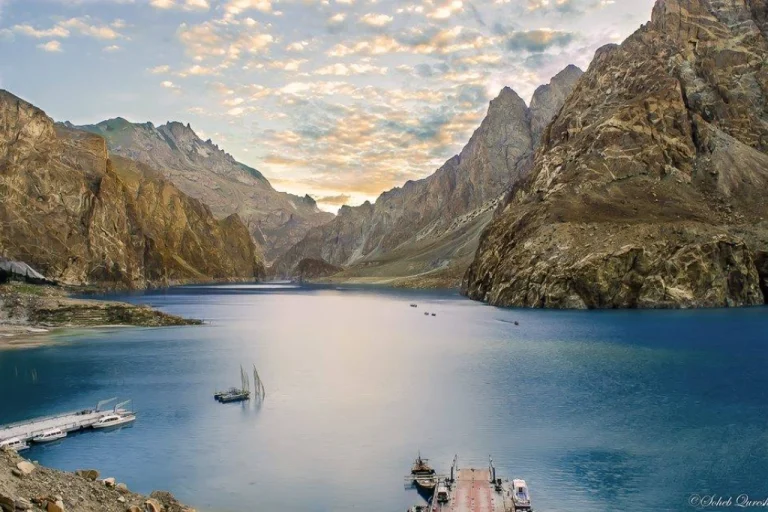Pakistan is a country of varied scenic beauty, housing some of the most beautiful alpine and glacial lakes in the world, situated between mountainous terrain, green valleys and snow-white mountains. Extending across the blue waters of the north and out to the quiet high-altitude mirrors of the heavens, these lakes provide not only visual beauty, but also adventure, relaxation, and cultural experience. Based on opinions and lists of the most beautiful lakes to visit according to popular travelers, these are 10 of the most beautiful lakes in Pakistan.
1. Saiful Muluk Lake
Located at 3,224 m in the Kaghan Valley of Khyber Pakhtunkhwa, Saiful Muluk is probably the most iconic of the Pakistani lakes that is surrounded by folklore about a prince and a fairy as recounted by the Sufi poet, Mian Muhammad Bakhsh. Its crystal-clear waters, covering 2.5 square kilometers, echo the surrounding Anso Mountains as a perfect mirror and more so on full moon nights when locals have it that fairies come to bathe. The gem of the alps, easily reached by a short jeep journey in Naran, is ideal to boat, hike and take pictures, with crowds of people thronging it during summer when its blue colors are ethereal in the presence of snow-white peaks.
2. Attabad Lake
Tragically, but turned into a turquoise paradise, Attabad Lake in Hunza Valley, Gilgit-Baltistan, developed in 2010 when a landslide blocked Hunza River creating a 21-km long reservoir at 2,559 meters. With its rich azure depths, that reach down to 358 feet, it serves as a stark contrast to the Karakoram Mountains, presenting adrenaline-inducing experiences such as jet skiing, boating, and cliff jumping. It is known as Little Switzerland of Pakistan, and is somewhere that you must visit, because of its relaxing but adventurous feel, and a new tunnel has made it easily approachable on the Karakoram Highway.
3. Ansoo Lake
This forgotten jewel at 4,245 meters of the Kaghan Valley, which takes a trekker a dream to find, was named after the Pakistani word Ansoo or the tear, revealed in 1993 by a pilot of the Pakistan Air Force. In the shape of a human eye, the frozen island forms the pupil and its glassy surface reflects the peaks of the Malika Parbat, reachable by a difficult 4-5 hour walk up Shogran. The isolation of the lake keeps it in its purest beauty and it is an idyllic place to escape in solitude with wildflowers and glacial streams in summer.
4. Satpara Lake
The Himalayas feed the Satpara Lake which is the Pride of the North of Pakistan, a 2.5 square kilometer lake at 2,636 meters in Gilgit-Baltistan. Its green waters glitters in the sun, with barren yet grand cliffs surrounding its borders, and the historic Satpara Dam that supplies its power. Good fishing, rowing, picnics, this fairy-tale-like place swarms in the spring with wildflowers, and has gorgeous sunsets that colour the lake with shades of gold and pink.
5. Sheosar Lake
Sheosar Lake in Gilgit-Baltistan, 4,142 meters above sea level, is a 2.3-kilometer-long bed of sapphire water in the Deosai National Park, the second highest plateau in the world above sea level. It is 40 meters deep and surrounded by alpine meadows, full of colors in summer, the nest of rare Himalayan brown bears. Accessible by jeep, Skardu, it is an animal-watching and stargazing destination, the flat expanse of the lake acts as a mirror to the sky on clear nights.
6. Rush Lake
Nagar Valley is Pakistan’s highest with 4,694 meters above sea level, which Rush believes to be the 25th highest alpine lake in the world, requiring several days of walking through the Hopar and Miar Glaciers. Rewarding adventurers with the 360 degree views of titans such as Spantik (7,027 meters) and Malubiting, its icy-blue waters shine through unending snowfields. Attempted by seasoned hikers during the months of July thru September, it is raw and untamed wilderness to those in need of the highway’s thrills.
7. Karambar Lake
Karambar, the second-highest in Pakistan and the 33rd-highest in the world, at 4,272 meters in the Ishkoman Valley, Gilgit-Baltistan, has blue waters 180 feet deep and abounds in trout amid isolated Pamir slides. Its biologically active ecology at such an elevation is a wonder, reachable with a rough walk through Broghil Valley. To the adventurer it is unsurpassed solitude, reflections of the Hindu Kush make a surreal canvas of the other world.
8. Ratti Gali Lake
Ratti Gali, in Neelum Valley, Azad Kashmir, at 12,130 feet, is surrounded by pine forests and snow peaks and its emerald waters are bordered by the alpine meadows of wildflowers. This heaven is accessed by a 19-kilometer walk up the mountain through the Dowarian base camp and is complemented by horseback riding and camping. Its accessibility and green environment make it popular among families and photographers who shoot in the mirror of the lake reflections.
9. Dudipatsar Lake
To its north end, in Mansehra District, Dudipatsar, the White Lake, with its snow-white shores, reflects the sky in unbroken clearness in summer. It is a part of Lulusar-Dudipatsar National Park, and can be approached by a scenic road leading to Besal (near Naran) and enclosed by deodar trees and mountains. This alluring place, open June to September, beckons picnics and even light hikes, and its crystal surface is a lyrical mixture of blue and white peace.
10. Rama Lake
Rama Lake is a spectacular sight set in Astore valley, around the formidable Nanga Parbat, changing its colour according to the sunlight, deeper green or turquoise blue. It is regularly covered with snow fed by glacial feces, which adds to its mystical charm being one of the most important ecological places in Pakistan. The entrance to the Rama meadows is a medium hiking trail showcasing its perfect beauty, perfect to see birds and contemplate under the shade of the killer mountain.
These lakes are not just scenic beauties, but for local ecosystems, cultural inspirations and economic engines with eco-tourism. You may be an adventure-lover climbing glaciers or a soul desiring peace, but these water jewels will surely engage your heart.
Check: Pakistan Tourism News







